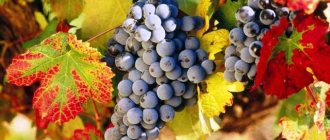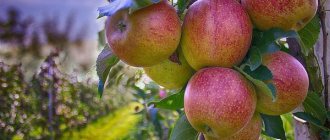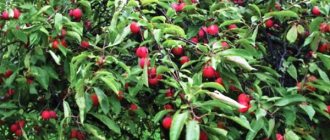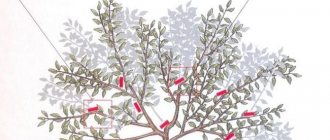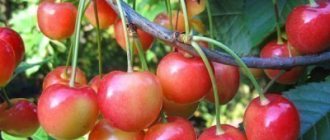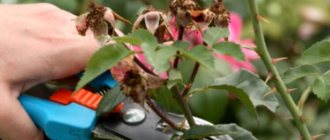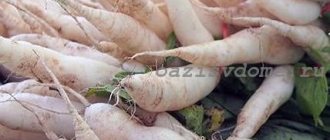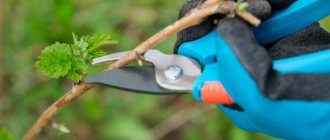Lifespan of grapes. Life periods of a grape bush
Life periods of the bush. In the life cycle of a grape bush, like fruit trees and shrubs, there are several periods.
For fruit trees, P. G. Schitt established several main age stages, covering all transitions between growth, fruiting and aging of plants.
In a grapevine that begins to bear fruit early, annual pruning eliminates some of the phenomena of aging of the above-ground parts (the dying off of the branches, the transition to self-healing of the bush by sprouting from underground organs). Therefore, the life of a grape bush is divided into three periods:
The growth period is the accumulation of vegetative power and partial fruiting, the shortest, lasting three to six years, depending on the shape of the bush, variety and cultural conditions.
The period of full fruiting is the longest, lasting 25-50 years, sometimes more.
A period of gradual weakening of growth and reproductive activity, lasting until the time when the planting becomes economically unprofitable and it is necessary to uproot it and plant a new one.
The average lifespan of a grape plantation in various viticulture regions ranges from 20 to 50-60 years.
In favorable growing conditions when standing alone, the grapevine reaches an age of 100-300 years. In cultivation, the lifespan of a grape bush is greatly reduced, age-related senescence occurs earlier, which is associated with cultivation methods and mainly with pruning.
Improved life expectancy
Growing grapevines in a healthy cultural environment reduces disease and increases life expectancy. Grapevines grow well in a variety of well-drained soils. Plants do not thrive in poorly drained, heavy clay soil. The preferred soil is deep, well-drained loam. Plant the vines in an area with full sun as the fruit requires sun exposure to ripen. Choose a location protected from strong winds to avoid damaging the woody vines. Avoid planting in areas that tend to collect standing water during rainfall.
Fruiting age of grapes
At what age do grapes begin to bear fruit?
If you believe the reference books, then in four years. But this is using industrial technology, when after planting a seedling, one shoot is left. In the fall it is cut into two buds, from two buds in the second year two shoots are obtained, and so on.
That is, they form the bushes slowly. This method is not suitable for gardeners at all. Therefore, winegrowers try to get the first bunch in the second year. And normal fruiting occurs on the third
It's all in the bottle
Industrial shaping is used mainly in non-irrigated vineyards. There the bush gradually gains strength with minimal care. And winegrowers speed up the process, achieving the first harvests very simply.
In February, cuttings are planted at home in plastic bottles. By the time they are planted in open ground in May, they have already gained almost a meter of growth. Next, they pinch a little, and with the help of stepchildren, they get two ripened shoots by autumn.
A good buy
But there is an easier way - buy a three-year-old seedling. He goes through the transplant painfully, but still throws away the brushes that he laid in the nursery or school. You just need to remove the excess ones so as not to weaken the plant too much, and in the first year you can try the berries. This is also convenient because you can immediately check the variety...
Berries from cuttings
Often, planted cuttings can throw out brushes. It is the formed buds that perform “miracles”. The bunches definitely need to be removed. But if you are sure that the cutting has already caught its roots in the ground, then leave a small part of the bunch, and after pollination, two or three berries on the bunch to check the variety. Of course, normal fruiting will occur in two years.
Stubborn Bush
It also happens the other way around. Despite all our efforts, the grapes do not bear fruit for three, four, or even five years. Most often, the culprit is drying of the roots during the sale of seedlings by the seller or during transportation. Such “dried fruits” can be distinguished by the absence of growth after planting for two to three years. You can speed up the process if you pour Kornevin’s solution on stubborn people. Pre-planting soaking of seedlings in water for one to two days or soaking the roots in a Heteroauxin solution for 10-12 hours also helps. Those seedlings that were planted at the wrong time “sit” in approximately the same way. The buds have begun to bloom, which means time has passed. Seedlings may be sick for several years, and the beginning of fruiting is delayed.
Too many tops
The completely opposite option is rapid growth and lack of fruiting. It happens when people get too carried away with nitrogen fertilizers (including manure) or water. Plants fatten and freeze in winter. And in the spring they grow back. I had a similar experience with one bush that grew near a leaking tap. It was “watered” three times a week and did not bear fruit for five years, freezing out during the winter. Until the faucet was replaced, the situation could not be corrected.
After four kidneys
Or there may be another reason for barren bushes - improper pruning. Most varieties do not form a cluster on the first three or four buds of annual vines. If you cut them short, there will be no harvest. The fact is that the grapes are formed in the buds in the heat. The first three or four are formed in June, when the temperature is still low. The best clusters are those of the middle buds on the vine, since they are formed in hot July and August, and the ends may not have time to ripen, because at this time it is already cool.
Therefore, they distinguish between short pruning for two to four buds (with such pruning only a few varieties bear fruit), medium for six to ten buds (suitable for most varieties), and long for 1224 buds (Asian varieties). Sometimes beginners cut out annual vines entirely. The grapes, of course, will not die - they will come from dormant buds. But there will definitely be no harvest. A couple of defective grapes on the stepsons do not count.
How to speed up
There are ways that will allow you to get a grape harvest in the 2nd year.
Plastic containers
One way to speed up the entry of grapes into fruiting is to root cuttings in plastic containers in January-February. By May, powerful seedlings with meter-long growths will be formed. All that remains is to harden them and plant them in a permanent place. And after adaptation, the cuttings need to be pinched correctly as soon as the first stepsons are formed. Such planting material provides trial clusters already in the 2nd year, and in the 3rd year it begins to bear fruit en masse.
Three-year-old seedling
By purchasing seedlings at the age of 3 years, you can also try the fruits in the first year. They endure the transplant painfully, but despite this, they throw away the brushes that they laid in the nursery.
Advice! During the growth process, trim off excess clusters so as not to weaken the plant too much.
Planting material
A lot depends on its quality and age. If you want to get the first harvest as quickly as possible, you should purchase a three-year-old seedling. Plants of the first and second years will not immediately produce a harvest.
If the seedling was transported or stored incorrectly, the roots could dry out. As a result, the plant becomes weakened and will not bear fruit soon. You can save a seedling by soaking the roots for a day in the Kornevin solution. It promotes the formation of new roots and strengthens existing ones.
Even if the seedling appears healthy, it should be disinfected before planting. A solution of iron sulfate will kill infections and pest larvae, if they were there, and also prevent their appearance.
Harvest time
Picking ripe fruit is important because grapes do not ripen. Fruit color is not the only indicator of ripeness. Try table grapes as they will become sweeter and less sour when ripe. Fruit requires an average temperature of 50 degrees Fahrenheit or more to reach ripeness. The best thing to do is to taste the fruit regularly and note the dates. Harvest when the taste is to taste. This makes it easy to focus on harvest dates in subsequent years.
Article on the topic: SUMMER PAGONI, VICHKA - Budova and the development of the vine - grapes
Pests and diseases of dogwood
Dogwood is highly resistant to many diseases and is rarely attacked by insect pests, but if agricultural cultivation practices are violated and unfavorable conditions may arise, some problems may arise. Thus, rainy weather can provoke the appearance of fungal diseases.
Let's look at them:
- Powdery mildew. This disease can be detected by a whitish coating. The leaves begin to turn yellow and dry out. To eliminate the problem, the bush is washed with a solution of laundry soap. In case of severe damage, copper-containing preparations such as “Hom” and Bordeaux mixture are used.
- Rust. In this case, reddish spots appear on the leaves on the back of the foliage. Over time, the leaves dry out and fall off. For treatment, it is recommended to cut off heavily affected branches and apply fungicides based on copper compounds.
Fungal diseases can significantly reduce the level of yield, so it is important to take preventive measures against their occurrence:
- make sure that there is no waterlogging and excessive thickening of the bush;
- remove fallen leaves and remove weeds;
- carry out spraying with Bordeaux mixture in early spring and autumn.
The snail worm is a dangerous pest. It affects the entire plant crop, including the roots. The most serious damage is caused by a subspecies of this pest that parasitizes the roots. The destruction of the bush goes unnoticed - no insects are visible, and the plant disappears. When the upper part of a bush (tree) is damaged, the scale insect can be seen by a sticky coating on which various fungi like to settle. Such a plant is disposed of or undergoes repeated treatment with preparations such as “Fufanon”.
Did you know? Phytoncides of dogwood berries inhibit pathogenic microflora, including the causative agents of dysentery and typhoid; they also have astringent properties and are useful for intestinal disorders. They contain a lot of anthocyanins, vitamin C, and pectin.
Dogwood will bear fruit faster if the seedling is obtained vegetatively, but the berries of a plant grown from a seed will have to wait a long time. Caring for it is not difficult, but for cross-pollination you need at least 2 varieties of plants. This crop winters well, is unpretentious and is practically not affected by diseases and pests.
Grape harvest. Post navigation
How to get a good grape harvest
To get a good grape harvest, you need to learn everything about this plant and learn how to care for it. This is what we will do. A grape is a perennial vine that lacks a strong skeleton, so it definitely needs support. It can spread along the ground and even take root. Planting is done with cuttings or ready-made seedlings; this plant develops very quickly, and the ground part is usually of significant size. She brings us the grape harvest.
grape harvest
The crop begins to bear fruit already in the 2nd year, and lives up to 80 years. What is this plant? Wild grapes look like a branched bush with many vines that begin to bear fruit late and irregularly. In order to avoid these unfavorable moments, cultivated grape varieties shape and shape the bushes. This makes caring for the crop much easier.
It is the care that determines how quickly the grapes will grow and how effectively they will bear fruit.
Grape care
In the first year, special attention is paid to growth - you need to make an effort to grow a strong and strong plant.
The soil should be weeded and thoroughly loosened. During the summer, this should be done approximately every 15-20 days to destroy weeds and crust that forms after rain.
20 days after planting, you should check the mounds to see if too much soil has been poured on them, as this circumstance complicates the growth of the plant. It makes sense to inspect the seedling for pests, such as fall armyworm caterpillars.
For better root development on grafted plantings, it is necessary to remove shoots and roots from the rootstock. A young plant requires a sufficient amount of moisture and minerals, so in dry weather the plant must be watered up to 4 times, and fertilizers should be applied 2-3 times during the summer.
A maximum of 4 shoots are left on each bush, it is recommended to remove the rest, and the growing shoots are tied vertically to pegs. This measure is necessary to ensure that the plant receives enough nutrition and develops properly. After the emerging leaves reach a size of 5 cm, the plant is treated with a 0.5% solution of Bordeaux mixture, and then sprayed with a 1.0% composition of the same preparation, depending on weather conditions, up to 10 times a summer.
Review of early varieties
When planting a vineyard, focus on crop varieties that are distinguished by early fruiting. The following varieties boast these characteristics.
Veles
The bush is vigorous, with well-ripening vines. Each shoot forms 2-4 inflorescences. Clusters weighing more than 3 kg have pronounced branching and a beautiful conical shape. The weight of one fruit is 4-5 g. Delicate pink fruits with dense juicy pulp with a nutmeg flavor. From one bush you can get 4-6 kg of berries.
The variety is high-yielding, fruitful, frost-resistant, and will be a good decorative addition to the site.
Long
A universal variety that ripens at the end of September. The growth vigor of the bushes is great. A bunch weighing 200 g has a conical shape and a dense structure. The berry weighs up to 3 g, oval, yellow-green in color. The pulp is juicy with a pleasant taste.
The disadvantage of the variety is considered to be instability to frost and fungal infections, and therefore requires a set of measures to protect against diseases and cold.
Isabel
Bushes of medium growth vigor, form medium-sized brushes, weighing 2-2.5 kg and cylindrical in shape. The grape fruits weigh 3 g, are round, black-violet in color with a thick coating of bluish-gray color. The skin is dense and durable. The pulp is pale green, sweet and sour with a flavor reminiscent of strawberries. Harvest occurs at the beginning of October. The first fruiting is observed in the 3rd year after planting the seedlings.
The variety is valued for its taste, low calorie content, high yield, and unpretentiousness in growth. A universal variety, it can be used both fresh and for the production of high quality wine and raw materials for various home preparations.
Kishmish
The bush forms shoots of great growth vigor, the vine matures at 2/3 of its length. The crop has large clusters that can weigh up to 1 kg. The small pink berries have a characteristic waxy coating and thin skin. Distinctive features of this variety are its sweet taste and the absence of seeds.
High yield and disease resistance make the variety attractive for cultivation.
Muscat summer
Grape bushes have the ability to reach 3 m in height. The plant is decorated with clusters of cylindrical shape, loose, fruits weighing up to 8 g, colored amber with a white tint. The pulp is juicy and sweet.
The variety is popular because of its yield, 40 kg of berries can be cut from one bush, early ripening and resistance to diseases and pests.
Noble
Grape bushes of great growth vigor with clusters in the shape of a cone, medium density, moderate looseness, weighing up to 700 g. Fruits weighing up to 16 g, green-yellow in color with dense skin that is not felt when eaten. The pulp is characterized by meatiness, juiciness and a pleasant nutmeg taste.
Fruiting is observed in the 3rd year after planting.
Augustine
A vigorous bush of grapes, forming conical clusters, weighing up to 600 g. The fruits are elongated oval in shape, amber in color, and when fully ripe, acquire a blush on the sides. The weight of one fruit is 7 g. The pulp is dense, fleshy with a harmonious sweet taste without a pronounced aroma.
Augustine does not require special climate conditions and bears fruit well and consistently even in the most unfavorable areas.
Alyoshenka
The grape bush is characterized by powerful growth force. The bunch is distinguished by its elegance and loose structure. The weight of the bunch ranges from 0.8 to 2.7 kg.
The berries are oval-shaped, amber in color with a light white waxy coating. The weight of each berry is 4-5 g. Crispy, juicy pulp with a pleasant taste.
Harvest occurs at the end of July. From one bush you can get approximately 25 kg of quality harvest.
Arcadia
The medium-sized plant has large, cylindrical clusters weighing up to 700 g. Fruits weighing up to 15 g, large, ovoid. The pulp is juicy, fleshy, amber in color with a neutral taste and a faint nutmeg aroma.
Advantages of the variety: productivity, winter hardiness, transportability.
Varieties and their overall productivity
The main characteristic of the variety is its yield. The description of any variety indicates which category it belongs to: low-yielding, medium-yielding or high-yielding.
The most productive varieties: Arcadia, Athos, Byzantium, Gourmet, Kishmish and other varieties with a bunch weight of 1 - 2.5 kg. On average, 10 - 25 kg of fruits are collected from a bush.
Violations committed in the dosage of fertilizing
If the bushes are “overfed” by applying nitrogen-containing fertilizers, the plant itself begins to develop intensively - leaves and branches grow luxuriantly, and the number of flowers and ovaries will decrease, and fewer fruit clusters will form. In addition to the reduction in yield, other important plant abilities are weakened: cold resistance, resistance to various types of diseases. The first sign of increased nitrogen content in the soil is the accelerated growth of young shoots. They will not have time to ripen before the onset of cold weather, and the bush will not survive winter frosts.
- It is advisable to apply organic fertilizers in the fall, while simultaneously reducing the amount of nitrogen fertilizers in the spring cycle by 50%.
- In spring and early summer, two additional feedings are also performed with a complex preparation: before flowering, before the plant sets fruit,
- after the berries have set.
What does productivity depend on?
The yield of grapes depends on the combination of many factors, which will ultimately give either an excellent harvest, or the result is far from your expectations. If we highlight the main criteria for good fruiting of grapes, then these include:
- Correct choice of planting material. You can plant grapes either with ready-made seedlings or grow the cuttings yourself until they are ready to be planted in open ground.
- Planting grapes. There are many nuances here that affect the final result, from the distance between the bushes to the depth of the planting hole.
- Choosing the right place and time of landing.
- Properly carried out annual pruning, with the correct formation of the bush and taking into account the adjustment of the load on the bush.
- High-quality preparation for winter and timely treatment of diseases.
- Watering and fertilizing.
- Plant age.
- Select a variety that suits your region. If you get the wrong variety, you may never see ripe grapes.
Diseases and pests
Each disease or pest significantly reduces yield. Let's briefly look at the main ones:
- When grapes are affected by downy mildew, the flowers and ovary dry out; with ordinary powdery mildew, the fruits burst and rot.
- Anthracnose and black spot cause blackness and death of bunches.
- Fruits affected by cercospora blight turn blue, wrinkle and fall off.
- With root rot, the bush itself dies.
- With gray rot, a fluffy coating appears on the grapes and foliage. The berries fall off.
- Phylloxera (grape aphid) is a very dangerous pest. She sucks the juices from the roots, the bush dies.
- The felt mite envelops the fruits in felt, and the growth of the bush slows down.
- Caterpillars of leaf rollers and mealybugs eat leaves and fruits.
What determines the start of fruiting?
Planting and caring for the vineyard according to the rules will allow you to enjoy the first berries already in the 2-3rd year after planting. But it happens that gardeners cannot achieve a harvest even in the 5th-6th year, since the fruiting of the crop depends on many conditions that were not taken into account when planting grape bushes.
There are several factors that influence the rate of berry formation.
Selecting a location
The culture is very demanding on where it grows, so when choosing a site, you should give preference to areas that are well-lit by the sun and reliably protected from drafts.
The plant will grow and develop poorly in cool lowlands and at the foot of slopes. Groundwater should approach the surface no more than 2.5 m. It is not recommended to place the vineyard next to fruit trees, as the plants will begin to compete for survival, this will negatively affect the yield.
Landing dates
The first rule for successful growth, rapid fruiting and high annual yields is timely planting. Because the air temperature and weather will determine how quickly the seedlings will take root and develop in the future.
Planting work should be carried out in the spring, when the soil warms up to +15 degrees. During the summer period, the roots adapt, this will allow the plant to survive the winter without problems.
The landing time depends on the climatic conditions of the region. In the southern regions, planting is recommended in February, in northern latitudes - in April and May.
Trimming
An important agrotechnical technique in obtaining a healthy plant is pruning, the purpose of which, during the period of accumulation of the vegetative mass of the bush, is to create a strong skeleton and well-developed annual shoots, as well as to give shape in accordance with the environmental conditions of growth.
Important! By cutting the grapes short, you can slow down their fruiting, and if you ignore the procedure, ripening will be delayed, since the plant will spend a lot of energy on weak, unnecessary shoots
Top dressing
The ripening of the vine depends on the amount of nutrients supplied during the growing season. Fertilizing with organic and mineral fertilizers will have a good effect on the speed of crop ripening. Add organic matter, phosphorus and potassium once every 3 years. In the spring, limit yourself to compost, and in the autumn, enrich the soil with manure.
A culture can also tell you what nutrients it needs. If the growth of grapes slows down, and the foliage becomes smaller and falls off prematurely, this signals a nitrogen deficiency. A lack of phosphorus causes darkening and lethargy of the leaves, and the loss of taste of the berries and yellowing of the leaves is considered a sign of a lack of potassium fertilizers.
Regional features
When growing, it is important to choose the right grape variety, taking into account the climatic conditions in which it will grow. To do this, you need to understand the timing of ripening so that the selected variety has enough heat for full ripening
Also take into account frost resistance and resistance to fungal diseases.
It is better to give preference to seedlings grown in natural and climatic conditions close to those in which it will be further cultivated.
Diseases and pests
Pests of grapes include spider mites and phylloxera. These insects are capable of destroying a crop in a short time. Diseases of grapes inhibit its development and fruiting, and can also cause the death of grapes.
Preventive procedures are considered effective measures in solving problems:
- Regular removal of weeds and loosening the soil will prevent pest larvae from settling in it.
- Spring treatment before the buds of the bushes against diseases and parasites using universal-purpose insecticides.
- Deep digging of the soil around the grapes in the fall, after harvesting and falling leaves. This operation helps to aerate the root system, retain moisture, and also destroy overwintering larvae.
- When diseases and pests appear, promptly carry out proper treatment, namely the elimination of infected parts of the plant, collection and subsequent burning of fallen leaves from infected bushes.
Carrying out preventive measures will help not only keep the vine healthy, but also reduce the waiting period for fruit.
How many years can you harvest?
All winegrowers are interested in the question, how many years does it take for grapes to bear fruit? The maximum limit is 26 years, the minimum is 9. And if you propagate the crop by branches, on which many strong shoots are formed annually, then the production of berries can be extended for 50 years.
The ability to bear fruit for a long time also depends on the selected variety of this berry crop. But there are many types of grapes that bear fruit for a long time. The choice is up to the winegrowers.
The growing process can be speeded up, but only slightly. But both in it and in conventional cultivation, the main thing is to properly take care of the planted grape bush. Protect him from diseases, treat him. If the need arises.
All this must be done with love. And then the usual routine process will turn into an exciting and useful pastime. And the resulting harvest will be a worthy and tasty reward for your work.
Errors
At first time
To obtain the first harvest, great importance is given to pruning and shaping the bush to adjust the correct load on the vine. The bush quickly becomes overgrown with excess green mass and young shoots, which consume 90% of the nutrients. The size and quality of the bunches decreases, the harvest will be poor.
If all the growing points on the shoots are cut off (all the stepsons are pinched), wintering points begin to grow, which should bear fruit next year, then next year the harvest will be meager.
With frequent and abundant watering, the green mass will begin to actively grow, the ripening of the bunches will be delayed, and the sugar content of the fruit will decrease. Therefore, in the second half of summer, when the berries ripen, watering is reduced.
All in all
If grapes are planted on the north side of the house or in the shade of trees, then the vine will reach towards the light, the bush itself will grow weak, rare flowers will fall off and there will be no harvest.
A seedling with a shallow planting will have roots that freeze in the winter and will dry out in the summer.
When the leaves dry out, you should not use abundant watering; this sign may be the beginning of a disease or a lack of nutrients. We need to figure out the cause and eliminate it.
Planting grapes in a garden plot is not difficult even for an inexperienced gardener. The main thing is to follow the necessary rules of agricultural technology. Their further growth, quality and quantity of the future harvest depend on how comfortable the planted bushes feel.
What to do and how to increase fruiting
To increase vineyard productivity you need to:
Correctly plan the location of the vineyard, preferably in the southeast, away from fruit trees and objects that cast a shadow on it. On the north side it is good to have protection from the wind in the form of a wall or other barrier. If the vine is growing in an unsuitable location, it can be replanted.
Buy a seedling that is 3 years old
Then the harvest can be obtained immediately.
When purchasing seedlings, pay attention to the absence of damage and dried roots.
When propagating by cuttings, plant them in containers at the end of winter at home. Then, at the end of spring, the grown bush can be planted in an open area, and the harvest can be expected the next year.
A variety with low-yielding characteristics can be replaced with a more productive one by grafting onto an old stump.
To increase resistance to frost, it is better to plant grapes in the spring, when it is warmer outside +15°C
In cold regions, the vines are insulated.
Provide moderate watering. The cuttings need abundant watering after they are planted in the ground - 1.5–2 buckets of water for each, 2 times a week. If you notice that the soil is very dry, water 3 times a week. In rainy weather the plant does not need additional watering. For a bush that has developed, 1–2 waterings per week are sufficient. Water for irrigation is collected in the morning and left to warm up in the sun until the evening. Do not water the crop from the end of August.
Diseases and insect damage When pruning, leave 8–10 buds; some varieties require even longer pruning.
You can encourage bees to land on flowers by sprinkling water with a small amount of honey on the inflorescences.
Male ones are planted next to female types of plants and vice versa, they can be grafted.
Regularly inspect the plant for diseases and pests, get rid of them, and apply preventive measures.
Fertilize correctly. Organic matter must be combined with mineral fertilizers: in the fall (before planting), spring or early summer, organic fertilizers must be mixed with superphosphate, and fertilized with potassium in the middle and at the end of summer. The consumption rate of organic fertilizers is 13 kg/m².
You need to fertilize the vineyard at a distance of 1 m from the vine, digging a hole in the ground about 0.5 m deep. Liquid fertilizers sprayed on the foliage from a spray bottle are also well absorbed.
Important! Do not use irrigation when the flowers have bloomed on the bush - this way you can knock them down and reduce the harvest with your own hands.
In order not to overdo it with fertilizers, you can focus on the following signs:
- The grape bush has small leaves, they fall off, the bush grows poorly - it is necessary to apply fertilizers containing nitrogen.
- Dark-colored leaves, loss of leaf elasticity—phosphorus-containing fertilizers are required.
- Yellowing of leaves, loss of sweet taste of grapes - potassium is needed.
Caring for first-year grapes in spring, summer and autumn
Spring grape care consists of fighting diseases, pests and unfavorable external factors. For protection, spray the plant with 1% Bordeaux mixture, which will prevent the development of fungal diseases. Regular laundry soap (1 piece per 10 liters of water) will help against grape moths, fleas and spider mites. In addition, immediately after planting, young plants need to be shaded from direct sunlight for a couple of weeks, for example, using spunbond, plywood, shading mesh or other available materials.
Caring for grapes in summer consists of regular watering and fertilizing, loosening the soil and weeding.
Watering and fertilizing grapes
After planting, the vine needs regular and abundant watering. Of course, how often to water the grapes depends primarily on the weather. But usually the plant is watered 10-15 days after planting and the procedure is repeated every 2 weeks. If it is hot and the soil dries out quickly, watering should be increased more often.
To water the grapes, use warm, settled water in a volume of 5-10 liters per bush.
The fertilizers that were applied during planting will provide the vine with nutrients for 2-3 years, so there is no urgent need for additional feeding. If desired, at the end of summer you can strengthen the plant with the following mixture: 10 g of potassium sulfate and 20 g of superphosphate per 1 sq.m. Then the grapes will be better prepared for winter.
Grape pruning
The main goal of pruning in the first year after planting is to give the bush the correct “direction” of growth so that it has two new strong shoots. To do this, immediately after planting, cut it to 2 eyes, removing everything else.
In the future, pruning of grapes will be carried out annually. Otherwise, thickened plantings will become a source of diseases and pests, and the yield will sharply decrease.
You can also carry out catarification - removal of the surface roots of the plant. This will allow the other roots to go deeper into the ground and successfully overwinter. Draw a hole up to 25 cm deep and carefully trim off the top roots and excess shoots. Then fill the hole with soil.
Young bushes must be covered for the winter, regardless of whether your variety is winter-hardy or not. The procedure is carried out when all the leaves have fallen, after the first slight frost. For shelter, you can use straw, spruce branches, spunbond and even slate.
If you follow proper watering of the grapes, regularly feed the vine and protect it from pests, the young plant will develop as successfully as the seedlings planted in the fall of last year.
Do you want to grow grapes? Care for beginners, collected in this article, will help you create a luxurious vineyard that will bear fruit with juicy berries every year.
Try planting a grapevine, perhaps you will become so interested in this activity that you will become a real expert. And if you already grow grapes, share your secrets of a rich harvest in the comments.
Selecting a location
Grapes should be planted at such a distance from all kinds of buildings that they do not cast a long shadow on the bushes, which can negatively affect the development of plants. If there is a stone wall or a wooden fence near the grape bushes on their northern side, then these bushes will receive more solar heat, since the buildings, heated by the sun, will give off heat to some extent to the air. In addition, such buildings will protect the vineyard from the harmful influence of northern winds. If a grape bush is directly adjacent to a tree, then it will shade it with its crown, and its roots will compete with the roots of the bush in the use of nutrients in the soil. As a result, such a grape bush will lag behind in development.
The root system of grapes penetrates deeply, several meters into the soil. Therefore, the close occurrence of water in the soil can negatively affect its development. Subsoil water should be no closer than two meters from the surface of the earth. If you plant grapes in a place where there is a lot of feces that appeared after cleaning cesspools, then the grape bush will develop poorly.
Such a place on a personal plot is unsuitable for planting grapes, and therefore it should be bypassed or feces should be removed from it, used for fertilizer, and the resulting hole should be filled with earth, which should be trampled underfoot. It is also necessary to clean the area clogged with stove coal ash.
If the vineyard is located near roads, it must be protected from dust. To do this, you should plant shrubs or trees at such a distance from the site that there is no shadow on it for a long time and the roots of the trees or shrubs do not enter the area where the grape roots are located. This distance must be at least 3 meters.
A garden plot with a southern or southwestern slope is the best for planting grapes, as it will be more generously warmed by the sun. The place for the vineyard, of course, should be inaccessible to poultry and animals that could cause harm to it.
What year after planting do grapes bear fruit and when do they begin to produce their first harvest?
Setting up a successful vineyard on your own plot requires the gardener to have a certain amount of knowledge on this topic.
It is important to study not only the basic agrotechnical measures, but also information about what year after planting the grapes are capable of bearing fruit. This will allow you to avoid many mistakes in the desire to get an early harvest and taste the first juicy berries already in the 2-3rd year
Fruiting start time
When growing unirrigated grapes on an industrial scale, the bushes are not allowed to bear fruit until they are four years old.
It is believed that only by this time the plant is able to produce a harvest without compromising the health and quality of the berries. The bush must have time to build up a sufficient volume of root mass before it begins to bear fruit.
The first four years of proper formation of bushes allow you to subsequently spend a minimum amount of time on caring for the vineyard
This is especially important for non-irrigated plantings of large farms. When the grapes begin to bear fruit, the bushes already have powerful roots up to 2-3 meters deep and a developed above-ground part of the bush
On your own plot, you can get the first bunches 1-2 years earlier. Regular watering and fertilizing remove most of the load from the plant in extracting moisture and nutrients. The task for the gardener after planting is to have time to grow a strong, mature vine during the season. This will determine in what year the grapes will be ready to produce the first inflorescences and fruits.
Using some agricultural techniques, you can stimulate the growth and development of the bush.
Rules of care
Before planting grapes, you need to prepare the soil to a depth of 100 cm. The entire layer is removed, a large volume of humus and compost is added, mixed and loosened. Heavy clay soils are additionally diluted with sand. Each bush is allocated at least 2 m in a row.
When choosing a location, it should be taken into account that it is not advisable to plant grapes next to large trees. They actively absorb moisture and nutrients around them.
Along the perimeter of the vineyard, at a distance of 4-5 m, you can plant perennial shrubs (currants, gooseberries), it will protect the plants from the wind and retain snow.
Before fruiting, young bushes are watered 4-5 times per season, helping the plants survive the driest times. By the end of summer, abundant watering can stimulate the active growth of shoots that will not have time to ripen before the end of the season.
It is necessary to ensure that a layer of soil of at least 1 meter is soaked. Surface moisture stimulates the development of roots in the upper layer of soil, which dries out first, and the plant becomes dependent on frequent watering.
To protect the vineyard soil from drying out and cracking, it is mulched with a thick layer of dry grass or straw.
In late autumn or early spring, humus is added to the digging in large quantities. During the first half of summer, instead of mineral fertilizers, you can water the grapes with mullein solution.
In the second half, it is better to switch to feeding with bird droppings. Foliar fertilizing with potassium fertilizers according to the instructions is useful.
Pruning of young bushes in order to speed up fruiting is done minimally. Remove excess and weak shoots so that the plant does not waste energy on them. One of the largest shoots is lightly pruned, leaving the middle part of the vine with the buds of the inflorescences. The second shoot is cut “on the sleeve”. Under favorable conditions, such grapes can bloom in the second year after planting.
In the first fruiting season, only one small inflorescence is left for sampling berries. If you do not remove the excess ovary, the plant will spend all its energy on ripening the fruits, this year’s vine will not ripen, and the bush will freeze in winter. In autumn, the bushes are carefully covered; the first and second winters after planting are the most critical. Young vines often freeze, which can delay fruiting for at least one season.
Early Harvest Methods
Planting three-year-old seedlings with proper care will allow you to get an early harvest the following year. Growing seedlings in a bottle from February accelerates the formation and ripening of a full-fledged vine, capable of bearing fruit in the second year.
Unlike growing grapes on an industrial scale, you don’t have to subject young plants to very short pruning on your own plot and allow them to bloom in the 2-3rd year. Regular watering and fertilizing stimulate accelerated growth of the root system and ripening of the vine, in contrast to non-irrigated vineyards of large farms. This allows you to get the harvest 1-2 years earlier.
Factors affecting fruiting
With proper care, you can taste the first grapes already in the 2-3rd year after planting. But sometimes the gardener cannot achieve a harvest even in the 5-6th year. The ability of bushes to bear fruit depends on many conditions.
Time
Vegetating cuttings with exposed dried roots, planted in late spring, will suffer for a long time; the vine most likely will not have time to ripen and will not survive the winter. Even with ideal care, you should not expect fruit from such grapes in the coming years.
Purchased seedlings must be taken with the root closed. If this is an autumn planting, then it is recommended to pay attention to the condition of the vine; this summer's growth should be mature (not green), and at least 6-7 mm thick. Such a seedling, well protected from the cold, will survive the winter well and can bloom the next season.
See also
Description of the Laura grape variety and fruiting characteristics, features of cultivation and careRead
In spring, grapes are planted in several ways:
- dormant cuttings in early spring before sap flow begins;
- already awakened vegetative cuttings (seedlings) in late May - early June;
- 2-3 year old seedlings before sap flow begins.
When planted using the first method, the plant takes root easier, suffers less, but most likely will not have time to produce sufficient growth to bear fruit the next year.
The second method involves planting cuttings at the end of February in plastic bottles in a warm place. By the beginning of May, the cuttings will grow up to 50 cm. When planting, carefully handle the plant without disturbing the earthen coma. Such a seedling, if well cared for next year, will most likely produce its first inflorescences. In this case, you can leave one small inflorescence on the strongest shoot and try the first berries.
2-3 year old cuttings do not always take root well, but with proper care they bear fruit the next year. In the year of planting, the inflorescences must be removed so as not to weaken the plant.
Place
The grapes are very demanding of sunlight and do not tolerate cool lowlands and the foot of the slopes. In a shaded, humid place, the grapes will quickly grow green mass; the vine will not ripen until the end of the season, will be fragile and thin, and will most likely freeze in winter. Such a vineyard may not bear fruit even in the 5-6th year. An area open on the south side, protected on the north side by buildings or trees, is suitable.
Trimming
When forming young bushes, it should be taken into account that the inflorescences are formed from the middle buds of last year's growth. Pruning too short can prevent the grapes from producing fruit in the early years. But lack of pruning can delay fruiting indefinitely. The plant spends too much energy on “unpromising” weak shoots.
Top dressing
The ripening of the vine largely depends on the amount of nutrients supplied during the growing season. Excess nitrogen stimulates large growth, but the vine “fattens”, becomes fragile and green, and flower buds form poorly.
A lack of potassium stops the development of shoots, the plant lags behind in growth, and the inflorescences fall off. The lack of organic components in the soil directly affects the taste and quality of the future harvest. On poor soils without the addition of humus and compost, grape bushes take a long time to build up their root mass and may not bear fruit for up to 5-6 years.
What year do grapes bear fruit after planting - Cottage, garden, vegetable garden, indoor plants
Every gardener, when purchasing a new fruit or flowering seedling, immediately imagines the plant in all its glory. Having planted grapes, you want to taste their delicious juicy berries as quickly as possible. But when can we expect the first fruits?
What can fruiting depend on?
Grapes are a fairly unpretentious plant to the soil. It categorically does not tolerate only swampy and highly saline soil. Without proper care, the shrub will produce a harvest, but the berries will be small and their ripening time will be late.
There are several factors that affect the speed at which fruit appears.
- Planting material.
- Landing place.
- Region.
- Boarding time.
- Watering.
- Lack or excess of nutrients.
- Trimming.
- Diseases and pests.
Like every plant, there are many factors influencing the rate of development of grapes. Let's look at each of them in more detail.
Watering and fertilizing
When overwatered, the plant puts all its energy into producing new growth. But the fruits are not enough. After massive non-ripening of the vines, the buds freeze in winter. If there is insufficient watering, the plant also suffers. The grapes simply do not have enough strength to form ovaries. Watering should be moderate.
The plant needs it most immediately after planting and in subsequent years during fruiting. In spring and autumn, when there is heavy rain, additional watering will be unnecessary, but in dry summer weather it will come in handy.
You can combine feeding the plant with nutrients with watering.
A full supply of organic and mineral fertilizers has an excellent effect on the volume and speed of crop ripening. Once every three years, the plant needs organic (about 13 kg per sq. m), phosphorus and potassium fertilizers. You need to add compost in the spring and manure in the fall. It is better to do spring fertilizing before removing the winter shelter from the bushes.
A healthy plant needs three feedings during the growing season.
- The first is carried out in the spring, when flowering has not yet begun.
- The second, for good formation of ovaries - just before flowering.
- The third is introduced at the beginning of fruit ripening.
The plant itself can tell you what substance it lacks. Upon careful examination, you can understand what substance needs to be added.
- when the grapes grow slowly, the leaves become smaller and fall off ahead of time - this is a sure sign of nitrogen deficiency;
- if the leaves darken and become limp, you need to add phosphorus;
- When the berries lose their sweetness and the leaves turn yellow ahead of time, it’s time to add potassium fertilizers.
Top dressing
For successful development, it is recommended to combine watering with fertilizing with useful substances. This helps to increase the volume and speed of fruit ripening.
During the growing season, the plant needs at least three feedings:
- In the spring months, before flowering begins.
- Just before flowering.
- At the beginning of fruit ripening.
Other feedings are carried out as necessary. When examining a plant, it is not difficult to determine what nutrients it needs.
Darkening and lethargy of leaves indicates a lack of phosphorus, too slow growth, shallowing and falling leaves - nitrogen, premature yellowing of leaves - potassium fertilizers.
Optimal place and time for landing
The question of what year grapes bear fruit does not have an exact answer. This is determined by many factors, the main one of which is the correct choice of place to plant the plant. The best site for this is considered to be a slope on the south or southeast side. This will stimulate rapid growth, as the sun's rays will illuminate the plant from all sides.
In this case, the distance between the bushes should be at least two meters. The vine also grows well near fences and house walls. But planting it in lowlands is not recommended.
Another important factor is the timing for planting seedlings. It is best to do this with the onset of heat, when the earth warms up above 15°.
At high temperatures, plants form powerful roots, and they take root faster and better. The best time for planting is spring, after the end of night frosts.
In the southern regions, plants develop faster than in the north, where with the onset of cold weather they can freeze. Therefore, in the northern regions, bushes must be covered for the winter.
Important: Grapes and fruit trees should not be planted nearby so that they do not interfere with each other with branches and roots. This will lead to a weak harvest
Grapes in the first year of cultivation - tips for proper planting and care
Adding an article to a new collection
Growing grapes for novice gardeners sometimes seems like a difficult task. This perennial vine loves when it receives maximum attention. Follow our tips to make sure you do everything right.
Grape bushes are often found in summer cottages, and all because growing a plant in the middle zone is not so difficult. Despite its whimsical nature, summer residents successfully plant bushes of various varieties and receive good harvests. If you decide to create a vineyard, late spring - early summer is the time to purchase seedlings and start planting.
Proper planting of grapes begins with choosing a location. The vine needs a lot of light and warmth, so choose an area protected from the wind, for example, near the south wall of a house or barn.
Water from the roof should not flow onto the grapes, otherwise they will die.
The soil is required to be as nutritious and loose as possible. Give preference to black soils with a high humus content. Also, grapes will successfully take root on rocky or sandy soil if you first add humus to the hole. The plant will like clay and peat soils less, so it is worth putting expanded clay, broken bricks, crushed stone or other drainage at the bottom of the hole.
On light sandy soils, grapes ripen 1-2 weeks earlier than on heavy clay soils.
